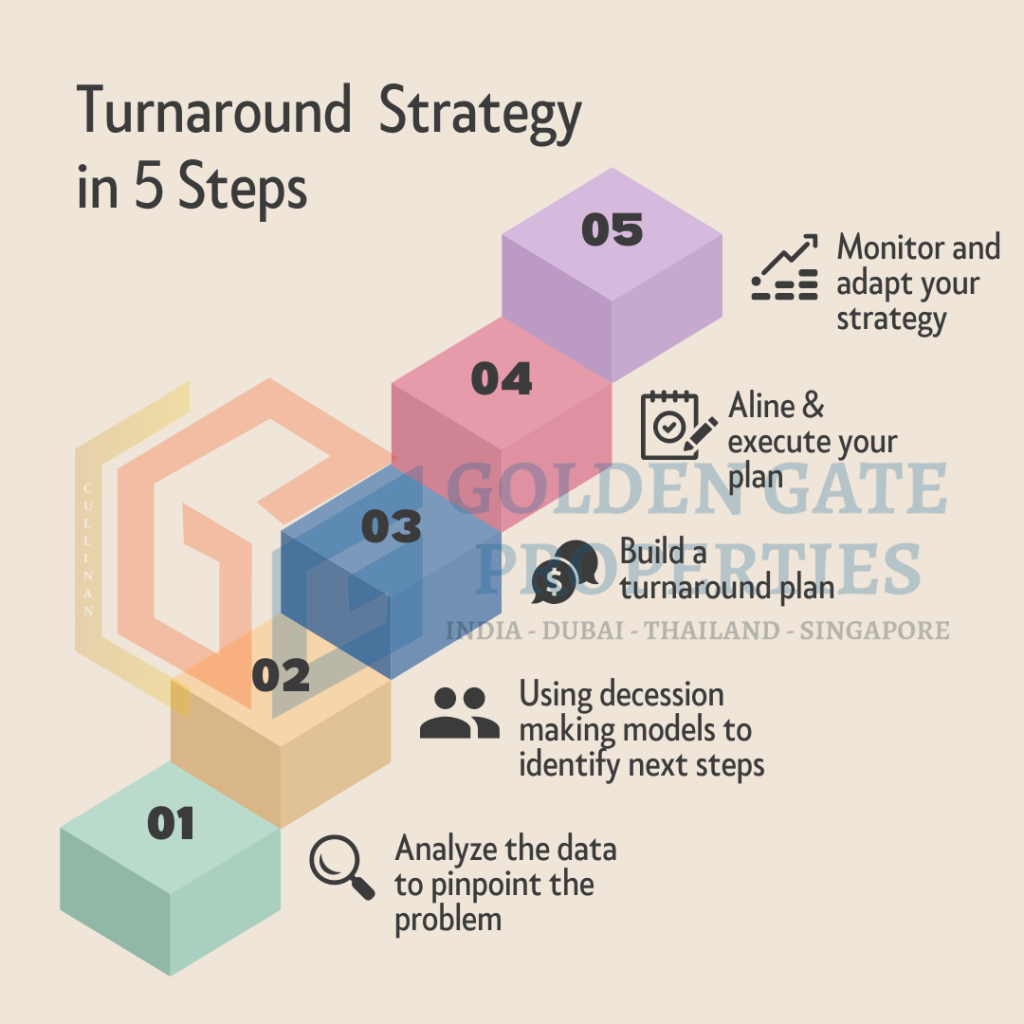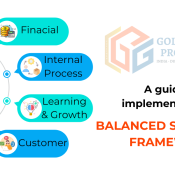
Turnaround Strategy: A Guide To Efficient Execution
When business throws you curveballs, your response time determines whether you swing, miss, or hit a home run. What about the subtle art? Noticing the little wobble of change before the pitch reaches you.
In the fast-paced world of business, those who foresee and strategically adjust not only survive but also create the rules. Whether you’re experiencing a squeeze or a light pressure, now is the time to rewrite your playbook.
In this post, we’ll teach you how to implement an effective turnaround plan and explain how other firms have succeeded.
What is a Business Turnaround Strategy?
A business turnaround plan is a series of measures and efforts that guide a firm from financial hardship or long-term issues, restoring profitability and resiliency. Some frequent problems are:
- Consistent drop in sales
- Mounting losses
- Cash flow difficulties
- Insolvency
- Poor management.
Turnaround plans contain defined short-term strategic goals that attempt to raise income, reduce expenditures, and restore the business’s sustainability after identifying the source of the problems.
A turnaround strategy is different from a change management strategy. Turnaround strategies are reactive and have a sense of urgency involved. Change management strategy, on the other hand, is a proactive approach that can be applied to situations like growth initiatives and process improvements.
When is the best time to implement a turnaround strategy?
The appropriate timing for assistance varies according to each business’s particular scenario. However, early intervention improves your chances of success. Here are clues that your company should undertake a turnaround strategy:
A long-term fall in financial performance, as indicated by decreased sales, profitability, and cash flow.
Growing losses influence financial stability and the capacity to satisfy financial responsibilities such as bill payment, wages, and capital expenditures.
Increasing unsustainable liabilities, particularly when debt payment becomes a major hardship.
Significant market upheavals render the current business model less competitive or outmoded, causing existing goods to lose market share.
An ineffective management team that struggles to make good judgements and adapt to quickly changing events.
Older procedures, high expenses, and deteriorating competitiveness all contribute to operational inefficiencies.
External causes include recessions, economic downturns, regulatory changes, and natural calamities.
Types of Turnaround Recovery Strategies
Turnaround methods are classified into numerous groups based on their strategy and focus:
Operational cost efficiency: This technique aims to improve internal processes, increase efficiency, and reduce costs. It frequently entails reorganising processes, optimising supply networks, and reducing waste.
Financial restructuring focuses on improving the company’s financial health through strategies such as debt restructuring, cost reduction, refinancing, and cash flow management.
Strategic turnaround management requires reviewing and changing the company’s overall business strategy. Actions include expanding into new markets, abandoning underperforming products or services, and diversifying product lines.
Market repositioning: This approach is focused on revitalising the company’s marketing and sales strategies. It includes rebranding, price tactics, and sales force enhancements.
Senior management reorganisation: This tackles leadership and management weaknesses by changing top management, providing leadership training, and implementing organisational reforms.
Product and service innovation: This is the process of creating new products or services that improve on current ones. Crisis management involves responding to an urgent crisis, such as a safety scandal, product recall, or public relations disaster. It focuses on reputation management, crisis communication, and implementing corrective steps.
5 Steps Of A Turnaround Strategy

While there may be different types of turnaround strategies, each follows the same basic steps below.
1. Analyse the data to identify the problem.
Examine your key company KPIs, including revenue and profit margins, as well as customer satisfaction levels.
Don’t go at it alone, though. Engage with important stakeholders, including as workers, investors, and consumers, to acquire vital insights and a common understanding of the challenges ahead.
2. Use decision-making models to choose the next step.
In a crisis, you cannot afford to be paralysed by indecision. Delays can lead to missed opportunities and greater financial losses. Indecision also results in poor resource utilisation, with funds stuck in unprofitable initiatives.
Use decision-making models and tools to swiftly analyse your position and plan your next moves. A decision matrix, cost-benefit analysis, and SWOT analysis are useful tools for prioritising and selecting the most important emphasis areas.
Speed is essential during a turnaround. Crises can evolve rapidly and what might have been an effective decision now, may not be the right move tomorrow.
Recommended Reading: The Best Way To Create A Decision Matrix
3. Create a turnaround strategy.
With a firm grasp of the problem and the necessary measures, it’s time to develop a precise turnaround strategy. A thorough plan should function as a roadmap, offering a clear path from point A to point B.
An effective strategy should include the following:
Strategic objectives
Key performance indicators (KPI)
Specific activities, efforts, or projects
Assigned Owners
Timeline with Key Milestones
Budget
dependencies, blockers, and hazards.
Connect with GGP to make complex strategies into simple, structured, and actionable plans so you can quickly move into the execution phase and track progress while including all the key elements above.
4. Align and carry out your plan.
Your turnaround strategy is just as effective as your organization’s capacity to implement it. Share the strategy with all relevant stakeholders and prioritise organisational alignment.
Ensure that everyone knows the primary strategic objectives and applies them to their everyday decision-making. This allows your key stakeholders to start working together towards a single objective. This will help you complete your turnaround strategy as quickly as possible.
To establish organisational alignment, regular strategy review meetings are required, but more on that later.
Recommended Reading: Aligning strategies horizontally and vertically
5. Monitor and adjust your plan.
Keep a tight eye on crucial measures, particularly leading indications that predict future performance. Leading indications will also assist you measure what is important. Some examples of lead indications are:
Customer satisfaction.
Pipeline growth
Prioritising important initiatives based on employee involvement
Supplier Risk
Continuous strategy assessments will help you identify potential risks and vulnerabilities early on so you can take corrective actions before they become major threats to your business.
Recommended Reading: Reviewing Strategy: How To Do It & What To Include
Case Studies for Successful Business Turnarounds
No firm is immune to significant upheavals, not even large corporations. The following companies saw a turnaround situation when it occurred and took the risk of pursuing new strategies.
Hershey

Chocolate was a luxury item for the wealthy before Hershey made it affordable for the ordinary household. This increased competition as other brands cashed in on the opportunity with their delicious treats.
Hershey’s initial strategy to keep costs low was to focus on a few product lines and increase production capacity. However, the increased competition forced them to introduce new products and acquire new brands.
They also pursued diversification strategies, such as acquiring the right to produce other consumer favourites like Cadbury and KitKat, which eventually kept them on the top.
Ford

In 2006, Ford was in danger of bankruptcy. The company experienced massive layoffs, billions of losses, and a lack of additional financing.
Bill Ford, the current CEO, recognized that the company needed a new leader and appointed Alan Mulally, a person with little automotive industry knowledge. Despite the shocking move, it proved lifesaving as the company adopted new strategic management practices that eventually turned their financial standing.
Alan Mulally created a culture of transparency that encouraged team members to seek support when they needed it. He replaced Ford’s pointless meetings with BPRs (Business Process Reviews) that helped leaders quickly identify areas that needed urgent attention using a streamlined prioritization method.
Dell

By 2011, PC global sales had peaked and started a steady decline. Dell was severely impacted and even regarded as a dying company. As smartphones and tablets took center stage, Dell’s annual sales saw double-digit declines, and attempts to bounce back were embarrassingly unsuccessful. Dell’s Streak “phablet” and Venue smartphone were both failures.
Michael Dell took the company private despite huge pushback from investors. This complex corporate strategy proved successful because Dell could take calculated risks and expand its services to include software solutions that more than doubled its enterprise value.
Before privatization, Dell had made key acquisitions in enterprise software and hardware solutions such as cloud storage and management. When the deal was completed, Dell went full force and offered not just its low-budget PCs but a whole portfolio of solutions, including data storage, systems management, cloud, cybersecurity, and cutting-edge software.
Dell reinforced its existing salesforce and positioned itself as a trusted advisor for all things tech. In just eight years after privatization, Dell’s equity increased by 625% and enterprise value topped $100 billion.
Execute Your Turnaround Strategy With GGP
Challenges are inevitable in the business world, but with a well-executed turnaround strategy, you can transform adversity into an opportunity for growth and success.
A strategy rooted in data and fast execution can make all the difference in your business rebound.




Nutra Gears This was beautiful Admin. Thank you for your reflections.
Thank you Do keep reading our upcoming blogs